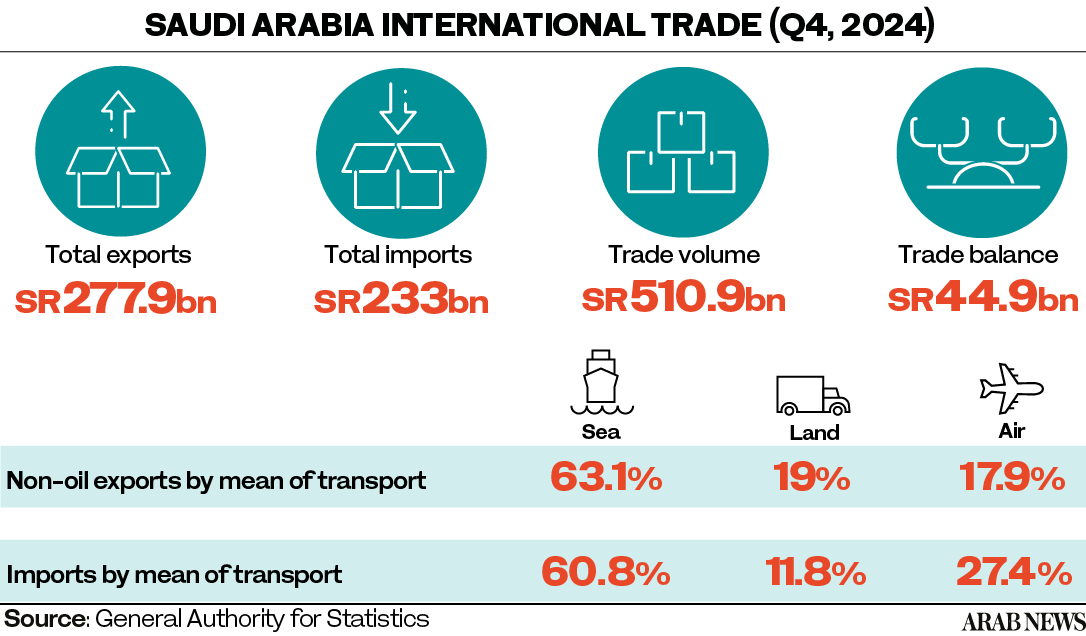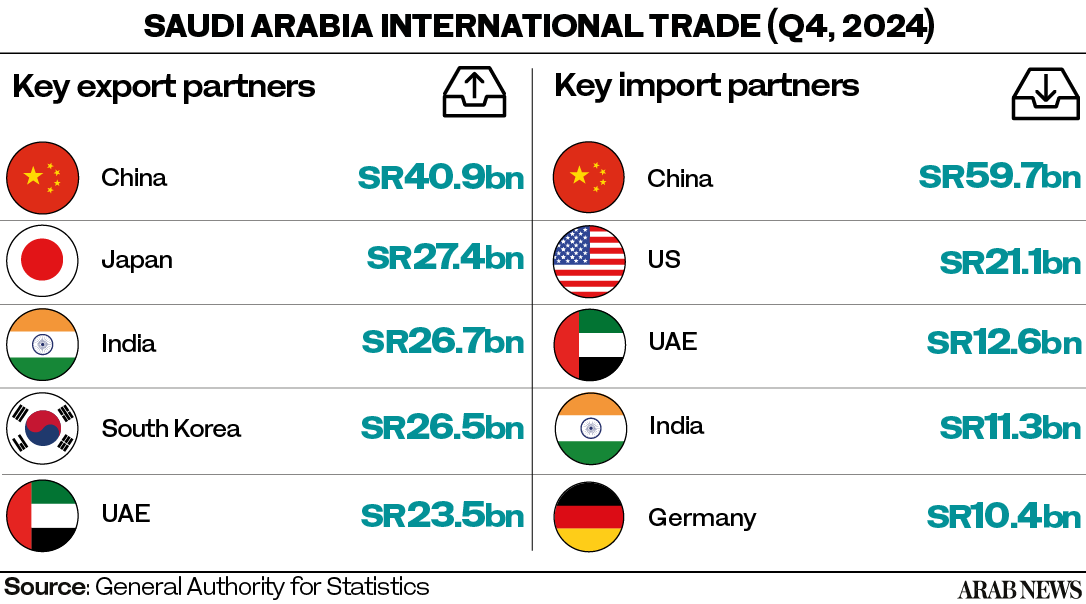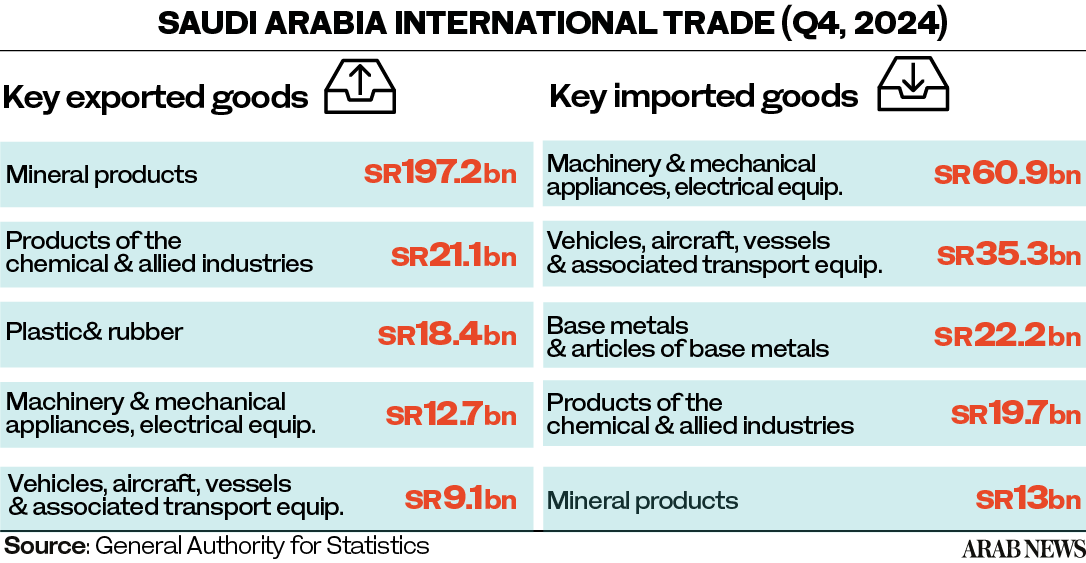RIYADH: Saudi Arabia recorded a trade surplus of SR44.89 billion ($11.97 billion) in the fourth quarter of 2024, driven by a 17.3 percent year-on-year surge in non-oil exports, official data showed.
According to the General Authority for Statistics, the Kingdom’s non-oil exports in the fourth quarter rose to SR82.05 billion, up from SR69.97 billion in the same period of 2023. Non-oil exports, excluding re-exports, increased 8.2 percent, while re-exported goods surged 47.3 percent.
While Saudi Arabia’s trade surplus grew in the fourth quarter, it remained 52.4 percent lower year-on-year as oil exports fell 13.3 percent, aligned with the output cut agreement made by OPEC.
The rise in non-oil exports underscores the progress of the Kingdom’s economic diversification efforts, which aim to transform the nation’s fiscal landscape and reduce reliance on crude revenues.

Speaking at the World Investment Conference in November, Saudi Minister of Economy and Planning Faisal Al-Ibrahim said non-oil activities have reached 52 percent of the Kingdom’s gross domestic product.
“The ratio of non-oil exports (including re-exports) to imports increased to 35.2 percent in the fourth quarter of 2024 from 34.7 percent in the fourth quarter of 2023. This was due to a 17.3 percent increase in non-oil exports and a 15.5 percent increase in imports over that period,” said GASTAT.
The Kingdom’s non-oil exports were dominated mainly by chemical products, which accounted for 25.8 percent of the overall outbound shipments.
GASTAT added that plastic and rubber products accounted for 22.4 percent of total non-oil shipments.
Despite a rise in outbound shipments for non-oil goods, Saudi Arabia’s overall merchandise exports decreased by 6.1 percent year on year in the fourth quarter, reaching SR277.93 billion, driven by a 13.3 percent decline in oil exports.

The percentage of oil exports out of total exports decreased from 76.4 percent in the fourth quarter of 2023 to 70.5 percent in the fourth quarter of 2024.
China was Saudi Arabia’s largest trading partner in the fourth quarter, with the Kingdom sending goods worth SR40.88 billion to the Asian nation.
Saudi Arabia also sent goods worth SR27.35 billion to Japan and SR26.68 billion to India in the fourth quarter of last year.

According to the GASTAT report, the Kingdom’s overall imports rose 15.5 percent year on year in the fourth quarter, reaching SR233.04 billion.
Saudi Arabia received goods worth SR59.66 billion from China, followed by the US at SR21.07 billion and the UAE at SR12.63 billion.
King Abdulaziz Sea Port in Dammam was the major entry point for goods in the fourth quarter, with the facility processing products valued at SR66.19 billion or 28.4 percent of the overall inbound shipments.
Non-oil exports increased by 18.1 percent in December
In a separate report, GASTAT said that Saudi Arabia’s non-oil exports in December amounted to SR29.45 billion, representing an 18.1 percent rise compared to the same month in 2023.
Chemical products accounted for 25.9 percent of the overall outbound shipments, while plastic and rubber products took a 22 percent share in December.
“The ratio of non-oil exports (including re-exports) to imports decreased to 37.3 percent in December 2024 from 40.1 percent in December 2023. This was due to the increase in non-oil exports at a lower rate than the rise in imports, with exports increasing by 18.1 percent compared to a 27.1 percent increase in imports during the same period,” said GASTAT.
The Kingdom’s overall merchandise exports decreased by 2.8 percent reaching SR94.29 billion in December compared to the same month of the previous year.
The share of oil exports from total outbound goods also decreased from 74.3 percent in December 2023 to 68.8 percent during the same month in 2024.
In December, Saudi Arabia exported goods worth SR12.52 billion to China, while South Korea received shipments from the Kingdom valued at SR9.80 billion.
Japan received inbound shipments from the Kingdom worth SR9.71 billion, followed by India at SR9.11 billion.
The report added that Saudi Arabia’s overall imports witnessed a 27.1 percent year-on-year rise in December, reaching SR79.03 billion, while the surplus of trade balance decreased by 56.1 percent, reaching SR15.26 billion.
China also dominated Saudi imports, with the Asian nation sending goods worth SR18.60 billion to the Kingdom in December, followed by the US with SR7.17 billion and the UAE with SR4.30 billion.
King Abdulaziz Sea Port in Dammam was the leading entry point for imports in December, with the facility handling goods valued at SR22.01 billion, or 27.8 percent of total inbound shipments.























